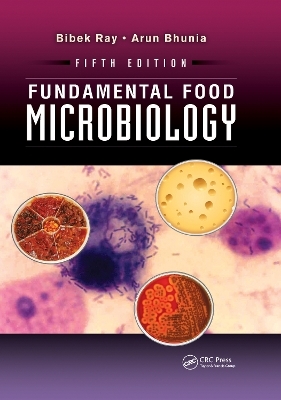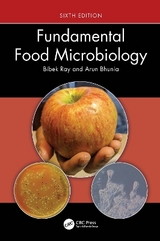
Fundamental Food Microbiology
Crc Press Inc (Verlag)
978-1-4665-6443-5 (ISBN)
- Titel erscheint in neuer Auflage
- Artikel merken
Capturing these developments, Fundamental Food Microbiology, Fifth Edition broadens coverage of foodborne diseases to include new and emerging pathogens as well as descriptions of the mechanism of pathogenesis. Written by experts with approximately fifty years of combined experience, the book provides an in-depth understanding of how to reduce microbial food spoilage, improve intervention technologies, and develop effective control methods for different types of foods.
See What’s New in the Fifth Edition:
New chapter on microbial attachment and biofilm formation
Bacterial quorum sensing during bacterial growth in food
Novel application of bacteriophage in pathogen control and detection
Substantial update on intestinal beneficial microbiota and probiotics to control pathogens, chronic diseases, and obesity
Nanotechnology in food preservation
Description of new pathogens such as Cronobacter sakazaki, E. coli O104:H4, Clostridium difficile, and Nipah Virus
Comprehensive list of seafood-related toxins
Updates on several new anti-microbial compounds such as polylysine, lactoferrin, lactoperoxidase, ovotransferrin, defensins, herbs, and spices
Updates on modern processing technologies such as infrared heating and plasma technology
Maintaining the high standard set by the previous bestselling editions, based feedback from students and professors, the new edition includes many more easy-to-follow figures and illustrations. The chapters are presented in a logical sequence that connects the information and allow students to easily understand and retain the concepts presented. These features and more make this a comprehensive introductory text for undergraduates as well as a valuable reference for graduate level and working professionals in food microbiology or food safety.
Bibek Ray, Arun Bhunia
SECTION I: INTRODUCTION TO MICROBES IN FOODS. History and Development of Food Microbiology. Characteristics of Predominant Microorganisms in Food. Sources of Microorganisms in Foods. Normal Microbiological Quality of Foods and Its Significance. SECTION II: MICROBIAL GROWTH RESPONSE IN THE FOOD ENVIRONMENT. Microbial Growth Characteristics. Factors Influencing Microbial Growth in Food. Microbial Attachments and Biofilm Formation. Microbial Metabolism of Food Components. Microbial Sporulation and Germination. Microbial Stress Response in the Food Environment. SECTION III: BENEFICIAL US ES OF MICROORGANISMS IN FOOD. Microorganisms Used in Food Fermentation. Biochemistry of Some Beneficial Traits. Genetics of Some Beneficial Traits. Starter Cultures and Bacteriophages. Microbiology of Fermented Food Production. Intestinal Bacteria and Probiotics. Food Biopreservatives of Microbial Origin, Bacteriocin, and Nanotechnology. Food Ingredients and Enzymes of Microbial Origin. SECTION IV: MICROBIAL FOOD SPOILAGE. Important Factors in Microbial Food Spoilage. Spoilage of Specific Food Groups. New Food Spoilage Bacteria in Refrigerated Foods. Food Spoilage by Microbial Enzymes. Indicators of Microbial Food Spoilage. SECTION V: MICROBIAL FOODBORNE DISEASES. Important Facts in Foodborne Diseases. Foodborne Intoxications. Foodborne Bacterial Infections. Foodborne Toxico-Infections. Opportunistic Bacterial Pathogens, Molds and Mycotoxins, Viruses, Parasites,. and Fish and Shellfish Toxins. New and Emerging Foodborne Pathogens. Indicators of Bacterial Pathogens. SECTION VI: CONTROL OF MICROORGANISMS IN FOODS. Control of Access of Microorganisms: Cleaning, Sanitation, and Disinfection. Control by Physical Removal. Control by Heat (Thermal Processing). Control by Low Temperature. Control by Reduced Water Activity and Drying. Control by Low pH and Organic Acids. Control by Modified Atmosphere (or Reducing O-R Potential). Control by Antimicrobial Preservatives and Bacteriophages. Control by Irradiation. Control by Novel Processing Technologies. Control by a Combination of Methods (Hurdle Concept). SECTION VII: MICROBIAL DETECTION AND FOOD SAFETY. Conventional, Immunological, Molecular, and Biosensor-Based Detection Methods. Appendix A: Predictive Modeling of Microbial Growth in Food. Appendix B: Regulatory Agencies Monitoring Microbiological Safety of Foods in the United States. Appendix C: Hazard Analysis Critical Control Points. Index.
| Zusatzinfo | 58 Tables, black and white; 87 Illustrations, black and white |
|---|---|
| Verlagsort | Bosa Roca |
| Sprache | englisch |
| Maße | 178 x 254 mm |
| Gewicht | 1314 g |
| Themenwelt | Technik ► Lebensmitteltechnologie |
| ISBN-10 | 1-4665-6443-1 / 1466564431 |
| ISBN-13 | 978-1-4665-6443-5 / 9781466564435 |
| Zustand | Neuware |
| Haben Sie eine Frage zum Produkt? |
aus dem Bereich



